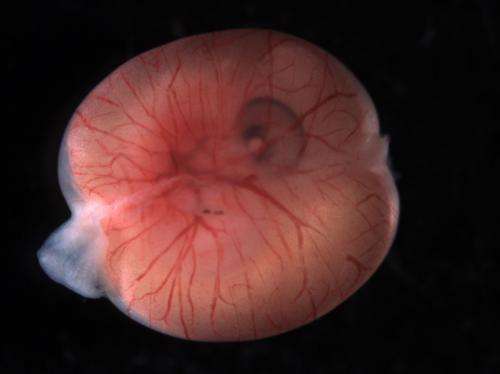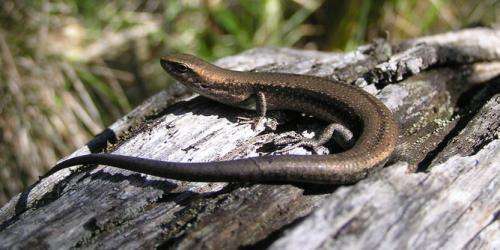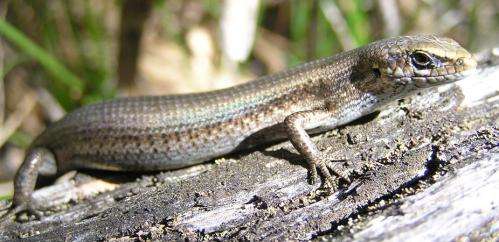Lizards help us find out which came first: the baby or the egg?

Have you ever wondered why we give birth to live young rather than lay eggs? Scientists have pondered this for a long time and answers have come from an unlikely source: some of Australia's lizards and snakes!
In research published this month in the American Naturalist, my colleagues and I at the University of Sydney studied reptile pregnancy to identify the factors necessary for a placenta to evolve.
Although most reptiles lay eggs, live birth has evolved many times in the group of reptiles that includes lizards and snakes.
Some of Australia's most iconic species, such as the blue-tongue lizards and red-bellied black snakes, have discarded egg-laying and instead hang onto their babies for the duration of pregnancy and give birth to fully developed young.
First came the egg
Evolution is a slow process, which means that many adaptations we see in animals today arose a long time ago. Pregnancy in mammals is no exception.
The earliest mammals laid eggs. A couple of these egg-laying ancestors are still around today – the platypus and echidna – and both are found in Australia.
From fossil evidence we know that today's live-bearing mammals had a live-bearing ancestor that roamed the earth 160 million years ago, so live birth in mammals must have evolved before this.
Understanding why evolutionary transitions that happened so long ago occurred can be difficult to infer. So researchers have to rely on systems where evolutionary transitions have occurred more recently.
Some lizards do it both ways – but why?
Live birth has evolved more recently in reptiles than in mammals. One Australian species, Bougainville's skink, has a live-bearing form on Kangaroo Island, off South Australia, but had an egg-laying form found on the mainland in South Australia, Victoria and New South Wales.
In cases where a single species has both egg-laying and live-bearing populations, we can infer live birth has evolved very recently. In these recent origins of live birth it is much easier to study why and how pregnancy evolves.
We know from reptile studies that live birth has several advantages over pregnancy.

In cold environments, eggs can have low survival rates because embryos are too cold to complete development. Meanwhile, pregnant mothers can either produce their own body heat (as in mammals) or can bask in the sun to warm themselves (as in reptiles), which keeps embryos warm enough to grow.

Pregnancy does offer one major disadvantage – mothers are burdened with the cost of carrying around their offspring for a long time. The mammal with the longest pregnancy is the African elephant, which can be pregnant for nearly two years.
In contrast, mothers that lay eggs get the advantage of their embryos developing in a nest. For most reptiles, this means that once the eggs are laid, they will leave them to fend for themselves.
What's needed for a placenta to evolve
Reptile live birth is very similar to mammalian live birth. After the eggs are fertilised, they are held inside the mother's uterus. As the embryo begins to develop, a placenta forms.
The placenta is the support organ for pregnancy. It allows mother and embryo to communicate and it allows the mother to provide nutrients to the embryo as it is developing.
Some reptiles have a placenta that provides all of the nutrients embryos receive before birth, just like most mammals. Some species have a placenta that is very simple and transfers very few nutrients, and only provides embryos with oxygen necessary for respiration.
But other species of lizard transfer an intermediate amount between these two extremes, and one such species is the Australian southern grass skink, found in some of Australia's coldest regions including the Blue Mountains, Snowy Mountains and Tasmania.
Studying this intermediate amount of nutrient transport allowed us to see how maternal diet during pregnancy might favour the evolution of a mammalian-like placenta. We found that mothers that ate more through pregnancy gave birth to larger offspring.
Some mothers ate their offspring
We also found that when food is limited, the mothers turned to a more sinister strategy to maintain their own body condition. They aborted and cannibalised their own offspring.
Although eating your offspring sounds like a terrible idea, it can be beneficial for mothers.
In environments where there is insufficient food, instead of giving birth to small offspring that have a low chance of surviving, the mother can regain nutrients by eating their offspring. Nutrients gained from cannibalising their offspring can then be used to produce more offspring in the next breeding season.
Because low food abundance resulted in unsuccessful pregnancies, we were led to conclude that nutrient provisioning by the placenta is only viable when mothers have predictable access to food throughout pregnancy.
What about birth in human ancestors?
This research allows us to tell a story about our own evolutionary history.
The first mammals laid eggs, then due to predation on eggs or perhaps cold temperatures, mothers held onto their eggs in the uterus until development was complete. They were much more successful.
In these first live-bearing mammals, the embryos required adequate access to oxygen and this induced the evolution of a placenta.
In an environment where food availability was predictable, females evolved to provide developing embryos with nutrients using the placenta, as occurs during pregnancy in humans.
Without studies on pregnancy in lizards and snakes it would not be possible to understand these evolutionary steps.
Next time you ponder why some particular trait has evolved, it might be worth considering if reptiles could shed some light on the answer.
Journal information: American Naturalist
Source: The Conversation
This story is published courtesy of The Conversation (under Creative Commons-Attribution/No derivatives).
![]()



















